This post may contain affiliate links. Learn more.
Pan seared filet mignon with shallot herb pan sauce makes an elegant, elevated meal. And it truly couldn’t be quicker or easier.
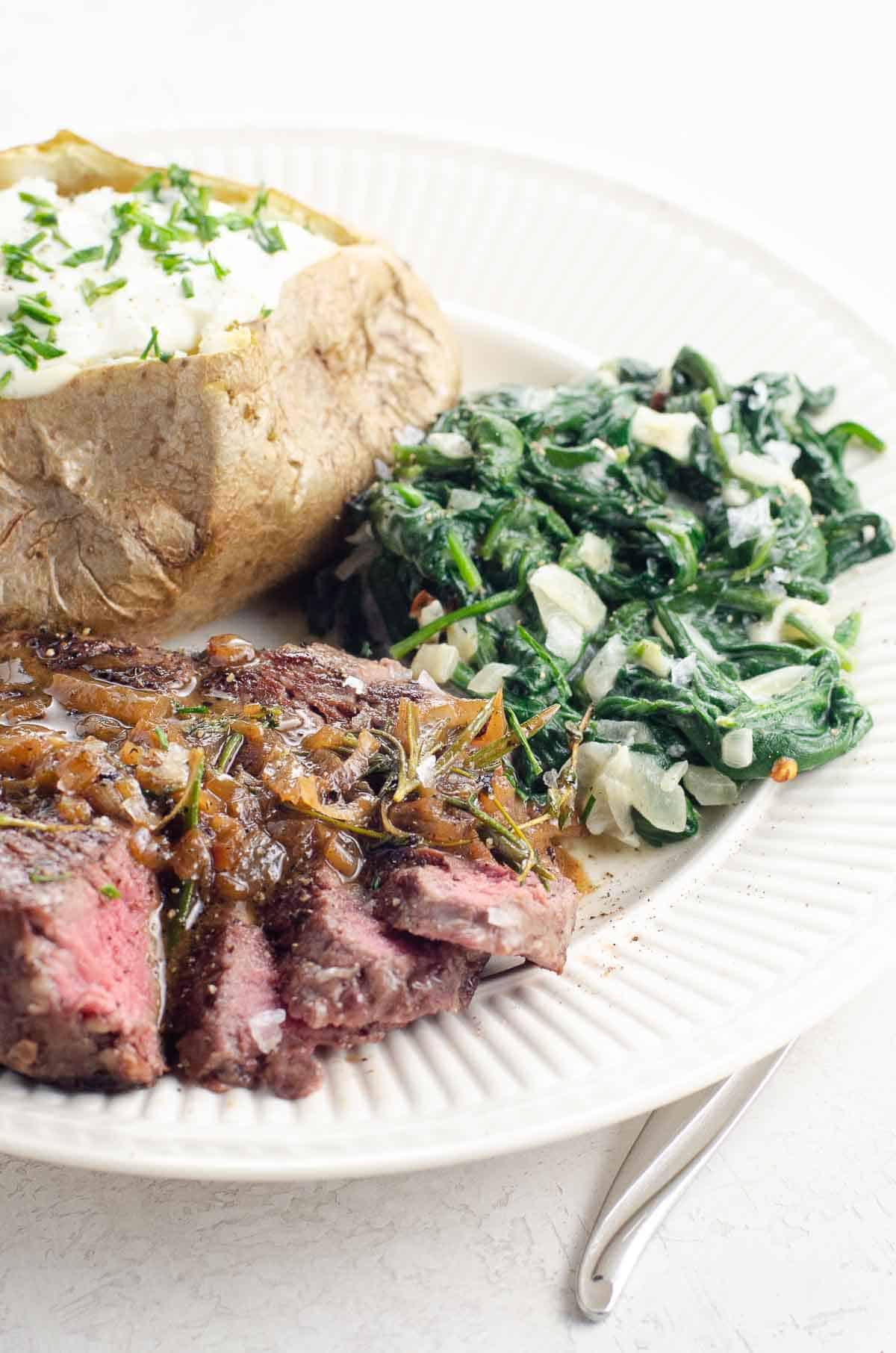
Why we love this recipe
Filet mignon is inarguably elegant. It’s one of those magical meals that’s ready in a flash but always feels special. Pan seared, with a quick shallot herb sauce, and portioned for two, it makes for an ideal date night. Or double it for a small dinner party or special family meal.
This recipe:
- Lets the flavorful tenderness of the filets shine through
- Gently enhances the steak with a silky sauce
- Pairs beautifully with classic side dishes — see the section below for ideas
I first published this recipe here back in 2019. I’ve since updated the post for clarity, but the recipe remains the same.
What you’ll need
Here’s a glance at the ingredients you’ll need to make this recipe.
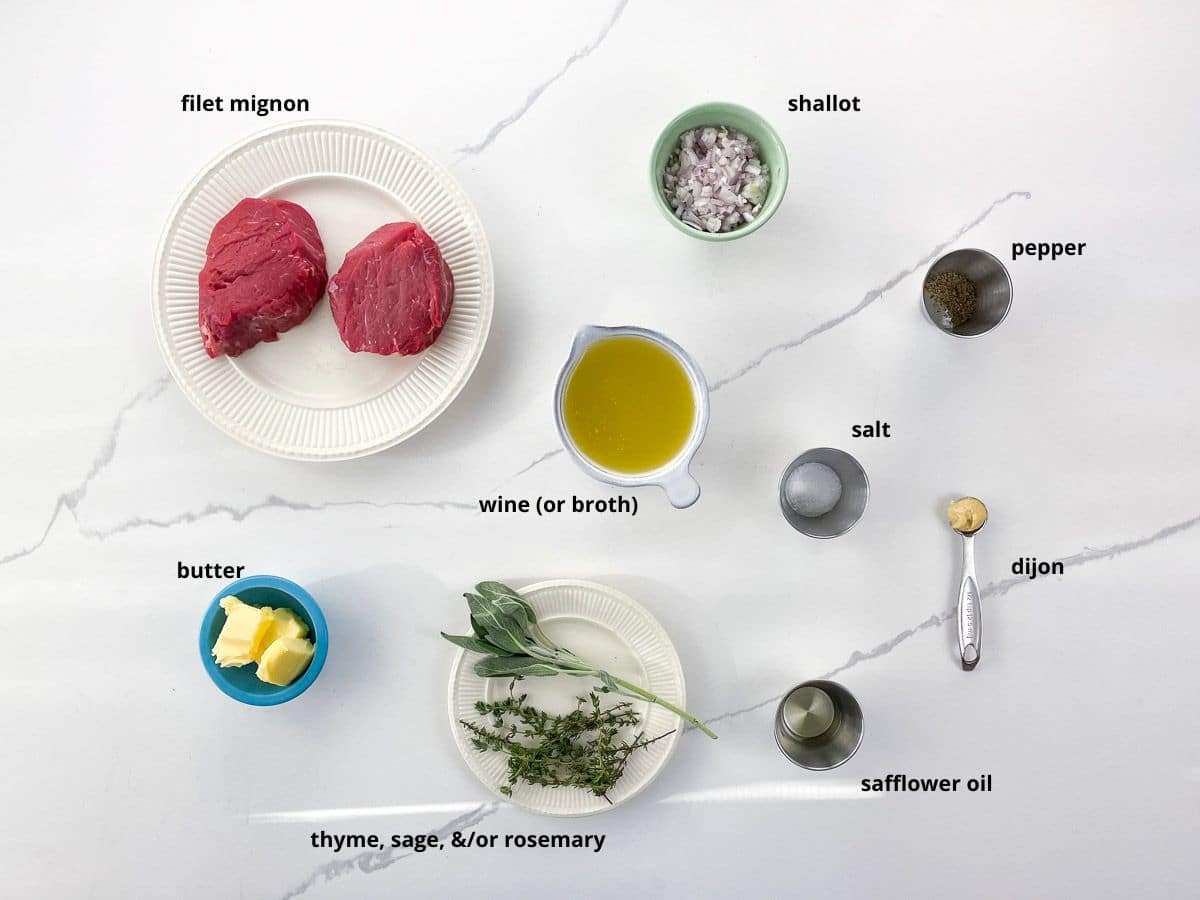
- Filet mignon is a steak cut from the end of the beef tenderloin. As the name suggests, it’s tender and delicate, largely due to the fact that it comes from a non-weight-bearing area of the cow. “Mignon” means cute or little and delicate in French. Filets come in different thicknesses — typically anywhere from about five to eight ounces per serving. With a smaller steak, you won’t need to transfer it to the oven. With a thicker one, a quick spin in the oven after searing is typically your best bet.
- You’ll season the steak generously with fine sea salt and freshly ground black pepper. You probably won’t need to add additional seasoning to the pan sauce.
- Safflower oil is my high-smoke-point, neutral-tasting vegetable oil of choice. You can substitute another oil that has similar properties, such as canola, sunflower, peanut, corn, or vegetable oil blend.
- You’ll use whole fresh woodsy herbs to flavor the sauce. Thyme, sage, and rosemary all work beautifully — you can use any or all of them that you’ve got.
- Shallot is one of my favorite alliums — it’s so full of nuanced, delicate flavor. Mince it so its texture enhances the sauce rather than getting in the way.
- A tiny bit of dijon mustard adds subtle flavor and also emulsifies the sauce.
- I’ve called for a dry white wine that you enjoy drinking, but you can use a light red like pinot noir, or beef broth, if you prefer.
- Use a really good-quality butter for the sauce if you can. Here and virtually everywhere, I start with a cultured, salted butter from grass-fed cows. This sounds fancy but doesn’t have to be. Kerrygold, for example, is sold in most supermarkets at a reasonable price.
My favorite sources for meat & pantry staples
For years, I’ve been sourcing our meat from ButcherBox. We love this curated meat delivery service, which provides grass-finished beef, heritage breed pork, organic chicken, and more from small farms direct to the customer. You can learn more in my extensive Butcher Box review and unboxing.
I love Thrive Market for a wide variety of products. Often described as one part Whole Foods, one part Costco, they’re a membership-based online market for healthier products at discounted prices. Plus, they’re mission-driven, engaged in the community, and not currently owned by a giant corporation. You can learn more in my Thrive Market review and unboxing.
How to make it
Here’s an overview of what you’ll do to make pan seared filet mignon with shallot herb pan sauce. You can see the steps in action in the video that accompanies this post, and get all the details in the recipe card below.
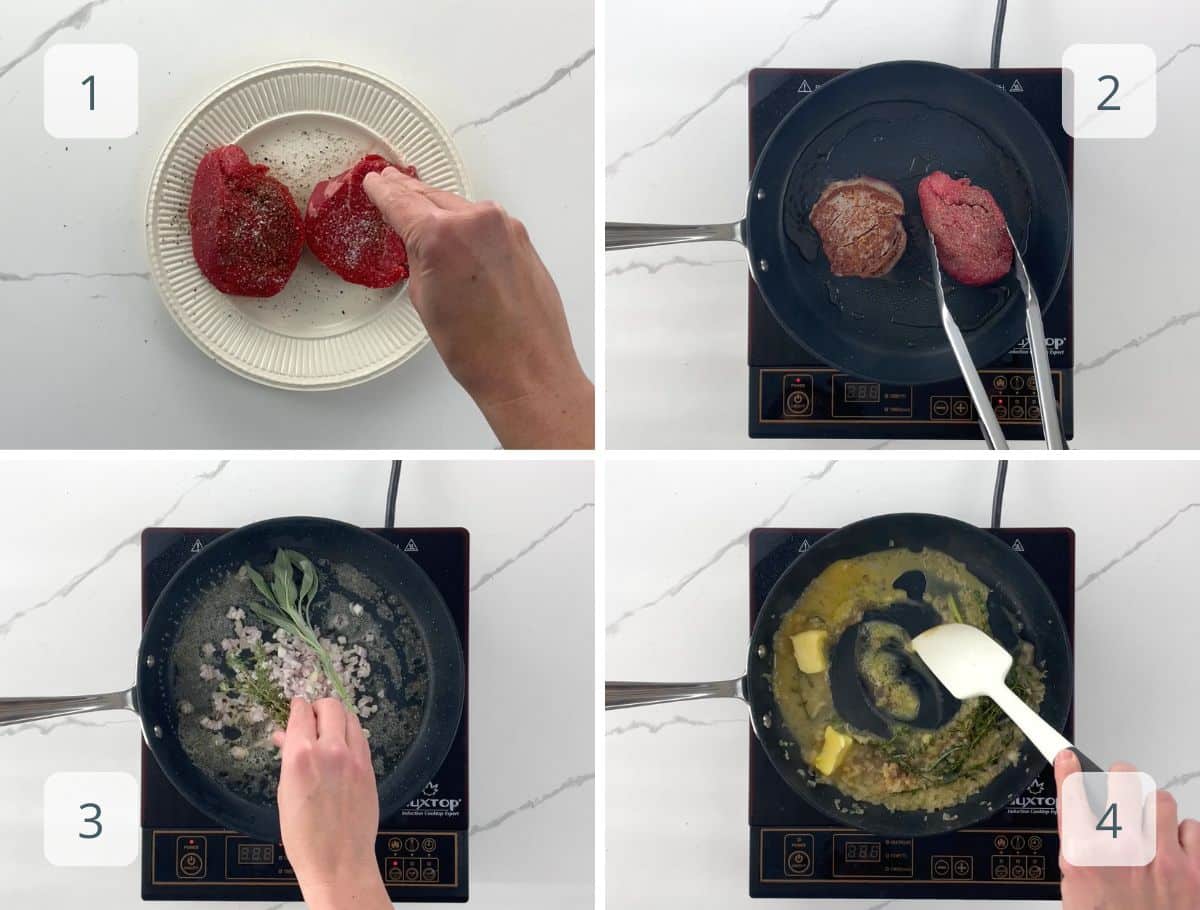
- First you’ll pat the steaks dry and season generously, and get the pan blazing hot.
- Swirl the oil into the pan. Add filets and cook undisturbed for about 3 minutes on the first side, until a nice brown crust forms. Flip once and brown on the underside, about 3 minutes more. You can also brown the edges if you like — I typically don’t. Depending on your steaks, this may be all you need to do. If they’re thick, you may transfer them to the oven per the instructions in the recipe card below.
- While the meat rests, you’ll make the sauce in the same pan.
- Off the heat, swirl in the remaining butter and any juices that have collected while the meat rests. That’s it!
Expert tips and FAQs
When filet has a light, simple sauce like this one, I like to serve a Pinot Noir or other similar, light-bodied red. If you’re doing so, you can use that wine in the sauce instead of the dry white, if you prefer.
In a word, yes. The price of filet mignon varies by region and by quality. But in general, since the filet is small and prized, it can be quite expensive.
For what it’s worth, I strongly prefer grass-fed and grass-finished beef for its environmental impact, taste, and nutritional profile, which can add to the cost. For years now we’ve been getting meat delivered by ButcherBox, and we love it. It’s of wonderful quality and the cost is remarkably low, considering.
Filet is tender, delicate, and low in fat, and it’s really enhanced by a simple shallot herb pan sauce. The filet needs to rest for five to 10 minutes after cooking, as all steak should do in order for the internal temperature to settle and the fibers to relax enough to absorb all the delicious juices.
This is the perfect window of time to make a simple sauce with a minced shallot, a few sprigs of rosemary and thyme, a splash of wine or stock, a dollop of dijon mustard, and a swirl of butter. It couldn’t be easier.
You don’t. The idea that steak should be at room temperature “for even cooking” is pure kitchen mythology. You can ignore it.
This recipe comes together quickly and shines shortly after that, so I wouldn’t recommend going out of your way to make it in advance.
That said, leftovers will keep well in an airtight container in the fridge for a week. Reheat gently to preserve the steak’s tenderness and the silkiness of the sauce. You can do this on half power in the microwave.
Can you reverse sear filet mignon?
In general, I’m a big fan of the reverse sear. However.
Just because you can reverse sear filet mignon does not, in my mind, mean that you should. Here’s our reasoning. First, a major draw of filet is its ability to shine bright with quick, no-fuss methods. Reverse searing takes a meal out of breezy, quick territory and into something a bit more time- and method-intensive. Since filet is so lean and tender to begin with, it’s best served rare to medium rare, which is easy to achieve with a regular sear plus a possible quick stint in a hot oven, and without fuss.
Reverse searing is best used when your cut of meat is at least 1 1/2 to 2 inches thick. Some filets are cut this thick, but some great filets aren’t.
Finally, while filet is tasty on its own, its delicate flavor benefits from a little enhancement, like the simple pan sauce in the recipe below. Regular stovetop searing produces slightly better sucs (a.k.a. browned bits at the bottom of the pan), and better sucs yield better pan sauce.
More favorite beef recipes
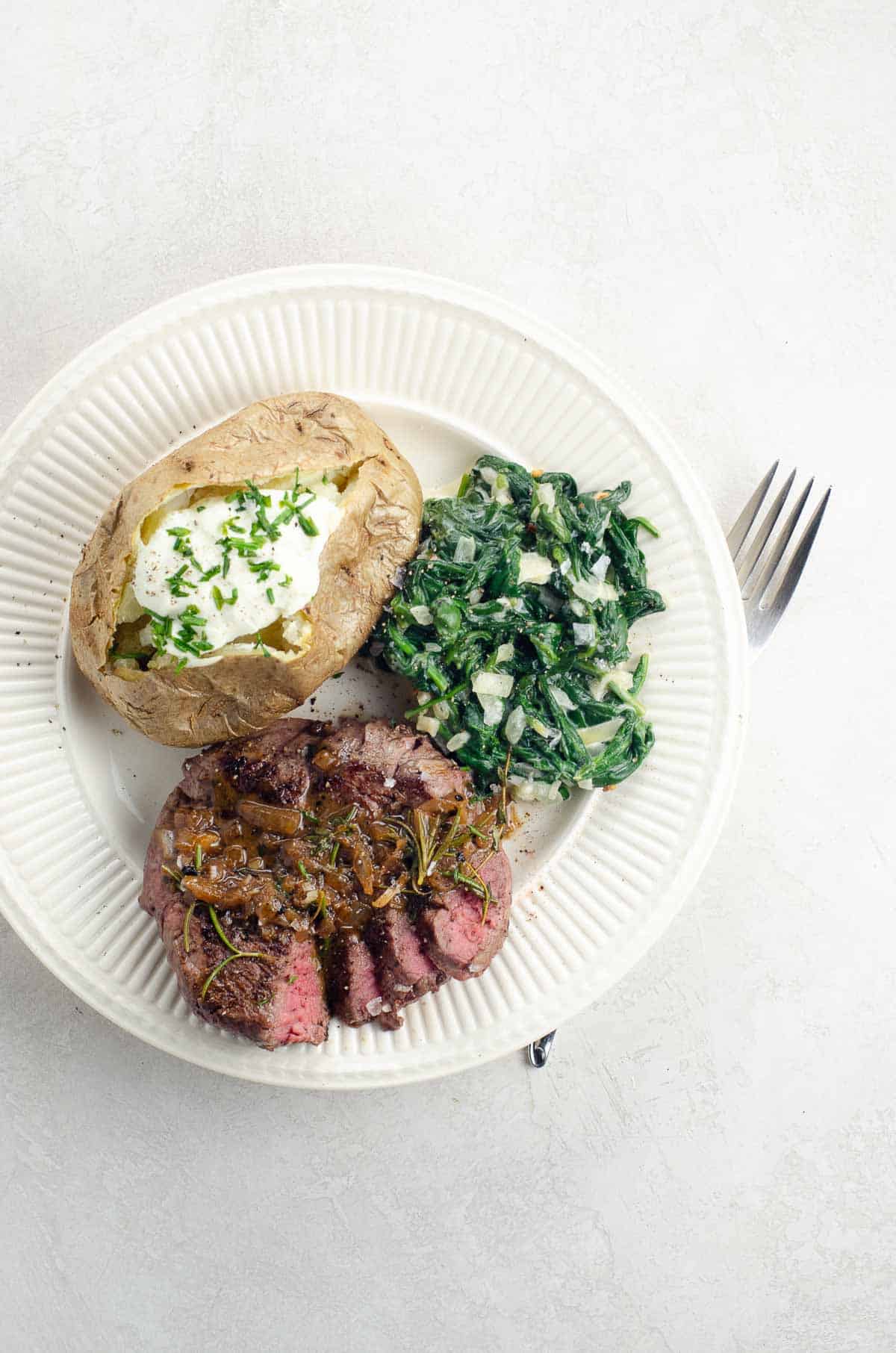
Hungry for more?
Subscribe to Umami Girl’s email updates, and follow along on Instagram.
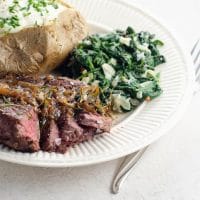
Pan Seared Filet Mignon with Shallot Herb Pan Sauce
Equipment
Ingredients
For the filets
- 2 6- ounce 170-gram filets mignons
- ½ teaspoon fine sea salt
- ¼ teaspoon freshly ground black pepper
- 1 tablespoon (15 ml) safflower oil
For the pan sauce
- 3 tablespoons (42 grams) butter, divided
- 1 medium shallot, minced (about 1/3 cup)
- 1 large sprig fresh rosemary
- 1 large sprig fresh thyme
- 1 small sprig fresh sage
- ½ cup (120 ml) dry white wine
- ½ teaspoon (3 grams) dijon mustard
Instructions
For the filets
- If your filets are thicker than 1 1/2 inches, preheat oven to 400°F with a rack in the center.
- Pat filets dry with paper towels and season with the salt and pepper.
- Heat a 12-inch cast iron pan over high heat until very hot.
- Carefully pour in oil and coat bottom of pan by swirling or spreading with a spatula.
- Place filets in pan and cook undisturbed for three minutes to sear. Flip once and cook about three minutes more. At this point, thinner steaks may be done.
- If meat does not yet read 125°F on an instant-read thermometer inserted into the center, you can continue searing for another minute or two — or, if you've got a ways to go, transfer pan to the oven.
- If necessary, transfer pan to oven and cook just until meat reads 125°F on an instant read thermometer inserted into the center. Depending on thickness this will take from two to more than five minutes, so check early and often. The filet will continue to cook off the heat, so pulling it out of the pan at 125°F (or even a little before, if you like), will yield a beautiful, true medium-rare (130°) finished product
- Transfer filets to a plate or cutting board to rest while you make the pan sauce.
For the pan sauce
- If pan still contains any cooking oil, pour it off, leaving any browned bits in the pan.
- Back on the stovetop, add one tablespoon of the butter to hot pan and carefully swirl to melt. (You can be slow to turn the heat on under the burner, since the pan will be very hot. When you do, set heat to medium.)
- Add shallot and herbs and cook, stirring frequently, until shallot softens, about two minutes.
- Add wine and mustard and stir to incorporate any browned bits on the bottom of the pan.
- Simmer for two to three minutes, until liquid is reduced by about half.
- Off the heat, swirl in remaining butter, along with any juices that have accumulated while the meat rests.
To serve
- Serve filets whole or sliced, as you like, with pan sauce spooned overtop.
- You can leave herbs in the pan or, if you like, pick off a few of the rosemary and thyme leaves and serve with the sauce.
Notes
- Safflower oil is my high-smoke-point, neutral-tasting vegetable oil of choice. You can substitute another oil that has similar properties, such as canola, sunflower, peanut, corn, or vegetable oil blend.
- Thyme, sage, and rosemary all work beautifully — you can use any or all of them that you've got.
- Mince the shallot (nice and small) so its texture enhances the sauce rather than getting in the way.
- A tiny bit of dijon mustard adds subtle flavor and also emulsifies the sauce, so don't skip it.
- I've called for a dry white wine that you enjoy drinking, but you can use a light red like pinot noir, or beef broth, if you prefer.
- Use a really good-quality butter if you can. Here and virtually everywhere, I start with a cultured, salted butter from grass-fed cows. This sounds fancy but doesn't have to be. Kerrygold, for example, is sold in most supermarkets at a reasonable price.
- This recipe comes together quickly and shines shortly after that, so I wouldn't recommend going out of your way to make it in advance. That said, leftovers will keep well in an airtight container in the fridge for a week. Reheat gently to preserve the steak's tenderness and the silkiness of the sauce. You can do this on half power in the microwave.
Nutrition
Nutrition information is automatically calculated, so should only be used as an approximation.
Hungry for more?
Subscribe to Umami Girl’s email updates, and follow along on Instagram.



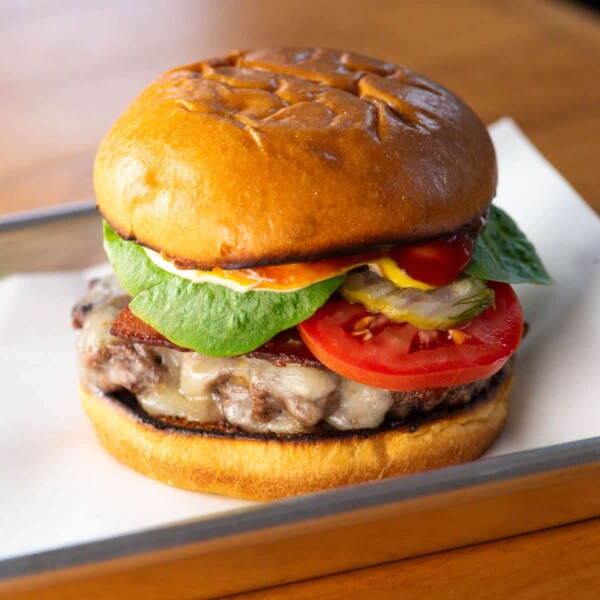
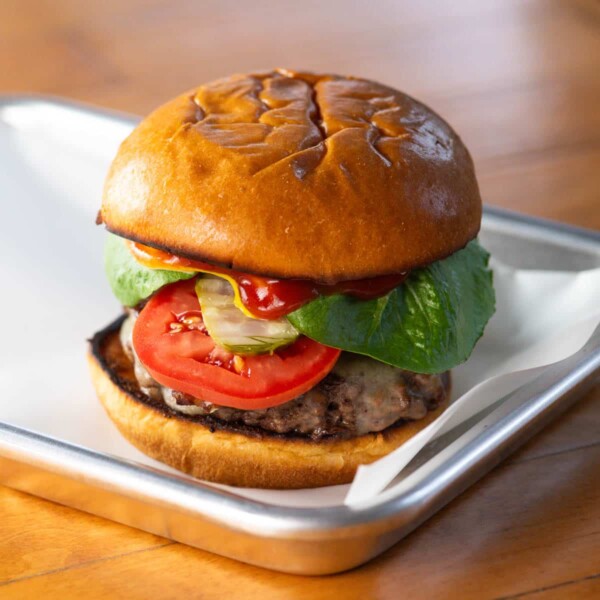
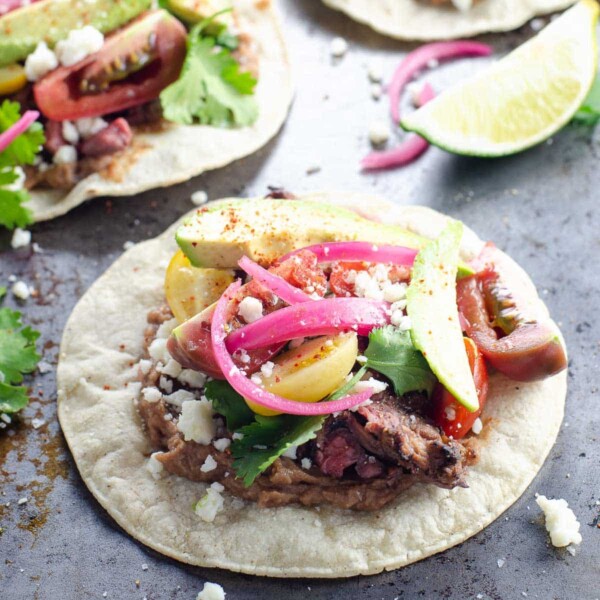







Your initial instructions say a 400° oven, but the recipe says preheat to 350° – which is the preferred temperature? Thanks!
Thank you for pointing out the inconsistency! 400°F is the correct temperature. I’ll fix it right now.